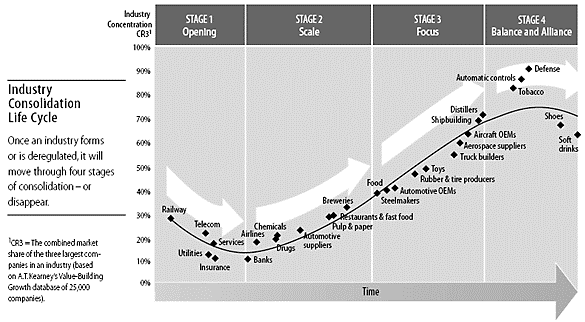Everyone knows that most new industries are fragmented and consolidate as they mature. But how does that work exactly? Our long-term analysis of mergers around the globe has found that most industries progress predictably through a clear consolidation life cycle—and that companies can plot with some precision where they fall in the cycle.
From our study of 1,345 large mergers completed over the past 13 years, we have concluded that, once an industry forms or is deregulated, it will move through four stages of consolidation (see the exhibit “Industry Consolidation Life Cycle”). Today, we predict, an industry will take on average 25 years to progress through all four stages; in the past it took somewhat longer, and in the future we expect it to be even quicker. But, our research suggests, every company in every industry will go through these four stages—or disappear. Thus, an understanding of where in the cycle an industry is should be the cornerstone of a company’s long-term strategic plan.
Stage 1: Opening
The first stage generally begins with a single start-up or with a monopoly just emerging from a newly deregulated or privatized industry. But this 100% industry concentration quickly drops off. Soon, the combined market share of the three largest companies drops to between 30% and 10%, as competitors quickly arise to create the frontier of industry consolidation. Newly deregulated or privatized industries throughout the world, such as energy, telecommunications, railroads, banking, and insurance, currently occupy this space. Start-ups in new fields such as biotechnology and on-line retailing also reside here, along with spin-offs that come from completely consolidated industries—as sports drinks and bottled water did from the soft-drink industry.
Companies in stage 1 industries should aggressively defend their first-mover advantage by building scale, creating a global footprint, and establishing barriers to entry by protecting proprietary technology or ideas. Stage 1 companies should focus more on revenue than profit, working to amass market share. And they should begin perfecting their acquisition skills, as these will be key to success in the next two stages of consolidation.
Stage 2: Scale
This stage is all about building scale. Major players begin to emerge, buying up competitors and forming empires. The top three players in a stage 2 industry will own 15% to 45% of their market, as the industry consolidates rapidly. Typical stage 2 industries include airlines, hotel chains, automotive suppliers, banks, and pharmaceuticals. Pfizer, in its recent acquisition of Pharmacia and Warner-Lambert, is a textbook example of a stage 2 company successfully positioning itself for the later rounds of consolidation that will yield the industry’s giants.
Because of the large number of acquisitions occurring in this stage, companies must hone their merger-integration skills. These include learning how to carefully protect their core culture as they absorb new companies and focusing on retaining the best employees of acquired companies. Building a scalable IT platform is also crucial to the rapid integration of acquired firms. Companies jockeying to reach stage 3 must be among the first players in the industry to capture their major competitors in the most important markets and should expand their global reach.
Stage 3: Focus
After the ferocious consolidation of stage 2, stage 3 companies focus on expanding their core business and continuing to aggressively outgrow the competition. The top three industry players will now control between 35% and 70% of the market. By this time, there are still generally five to 12 major players. This is a period of megadeals and large-scale consolidation plays; the goal is to emerge as one of a small number of global industry power-houses. Typical focus-stage industries include steel producers, automotive OEMs, shipbuilders, and distillers. GM’s acquisition of stakes in Isuzu, Subaru, Suzuki, Daewoo, Saab, and Fiat is an example of a solid stage 3 strategy.
Companies in stage 3 industries need to emphasize their core capabilities, focus on profitability, and either shore up or part with weak businesses. The well-entrenched competition at this phase will attack underperformers. Recognizing start-up competitors early on allows focus-stage competitors to decide whether to crush them, acquire them, or simply emulate them. Stage 3 companies should also identify other major players that will likely survive into the next, and final, stage and avoid all-out assaults.
Stage 4: Balance and Alliance
Here the titans of industry reign, from tobacco to soft drinks to defense. The industry concentration rate plateaus and can even dip a bit as, at this stage, the top three companies claim as much as 70% to 90% of the market. Large companies may form alliances with their peers because growth is now more challenging. Companies don’t move through stage 4; they stay in it. Thus, firms in these industries must defend their leading positions. They must find new ways to grow their core business in a mature industry and create a new wave of growth by spinning off new businesses into industries in early stages of consolidation. They must be alert to the potential for industry regulation and the danger of being lulled into complacency by their own dominance.
Ultimately, a company’s long-term success depends on how well it rides up the consolidation curve. Speed is everything, and managers’ merger competence is paramount, particularly during the middle stages of consolidation. Companies that evaluate each strategic and operational move according to how it will advance them up through the stages—that capture critical ground early and move up the curve the fastest—will be the most successful. Slower firms eventually become acquisition targets and will likely disappear. Most companies simply won’t survive to the endgame by trying to stay out of the contest, or worse, by ignoring it.
By Graeme K. Deans, Fritz Kroeger and Stefan Zeisel


